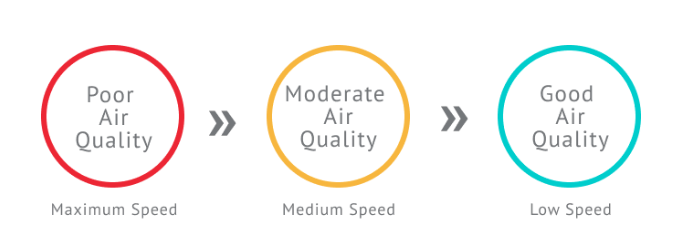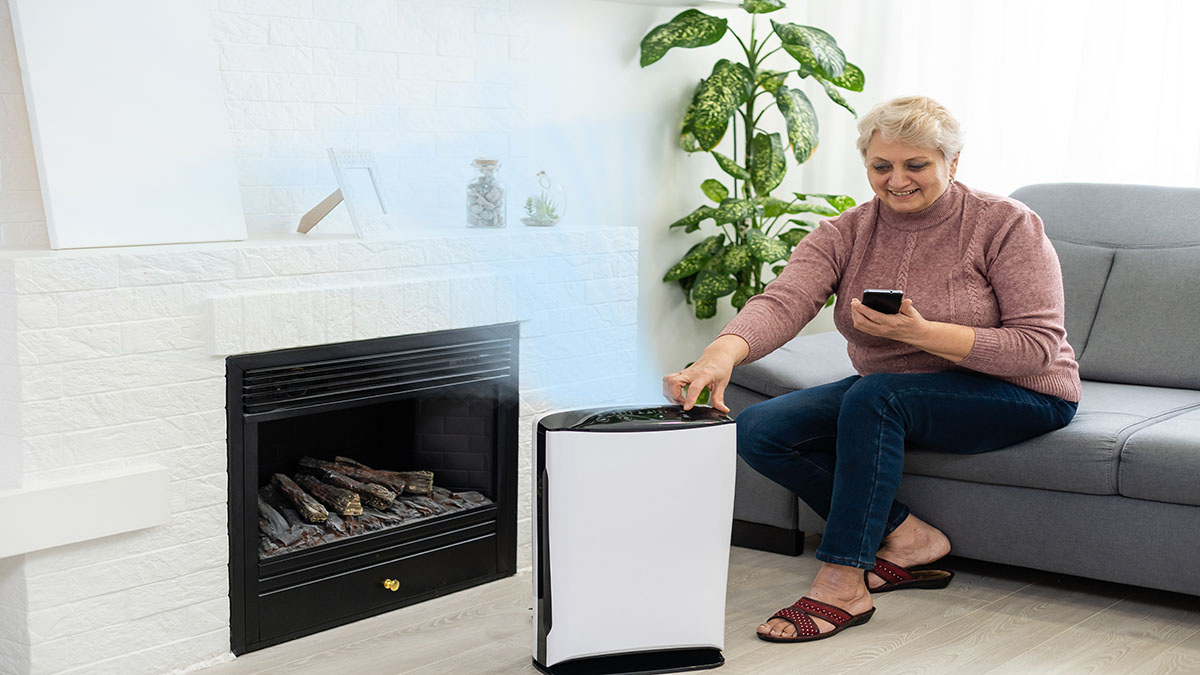If you recently purchased an air purifier, you may wonder, “Is your air purifier working to improve indoor air quality?” Fortunately, there are a few ways to check if your air purifier works effectively.
You can perform simple tests to determine if your air purifier is working.
- Examine the Filter: A primary indicator of your cleaner’s functioning is the state of its filter. A dirty filter suggests it’s time for a replacement.
- Air Quality Sensor: If your model includes this feature, it can provide insights into the purifier’s performance.
- Filter Indicator Light: This light is a useful signal to determine if filter maintenance is required.
- Assess Airflow: Weak airflow might indicate a problem with the purifier’s functionality.
- Monitor Noise Levels: Unusual noise can also indicate operational issues.

A common reason your air purifier is not improving your home’s air quality is the air purifier’s size. Look at your air purifier’s Clean Air Delivery Rate (CADR). This rating indicates how efficient the purifier is at removing airborne particles of different sizes. A higher CADR signifies better performance in cleaning the air in your space.
To ensure your air purifier is the correct size, multiply the length by the room’s width. Ideally, the air purifier should cleanse the air 2 times per hour or 4 times per hour for several allergy sufferers.
You may need a larger air purifier (or multiple air purifiers) to achieve your desired indoor air quality.
Read More: Best Air Purifiers & Reviews

Understanding Air Purifiers
Air purifiers serve the crucial function of cleansing indoor air, particularly in homes and offices. They effectively remove pollutants, allergens, and harmful particles, aiding in easier and healthier breathing. The market offers diverse air purifiers, each with unique features and capabilities.
- HEPA Air Purifiers: These devices, known for their High-Efficiency Particulate Air (HEPA) filters, excel in capturing extremely small particles, down to 0.3 microns. This makes them highly effective against allergens, dust, and other common air pollutants.
- Ionic Air Purifiers: Utilizing ions to trap and eliminate pollutants, these purifiers are particularly adept at removing smoke, odors, and fine particles from the air.
Importance of Indoor Air Quality
You spend most of your time indoors, whether it is at home or work. Therefore, the quality of the air you breathe indoors is essential to your health and well-being. Poor indoor air quality can cause various health problems, such as allergies, asthma, headaches, and fatigue.
The Environmental Protection Agency (EPA) has identified indoor air pollution as one of the top five environmental risks to public health. The EPA also states indoor air can be two to five times more polluted than outdoor air. 1
To ensure that the air you breathe indoors is healthy, monitoring indoor air quality (IAQ) regularly is essential. An indoor air quality monitor can help you assess the air quality in your home or workplace. We recommend the Airthings Wave Plus air quality monitor.
IAQ assessments can also help you identify potential sources of indoor air pollution, such as dust, mold, pet dander, and chemicals. Once you identify the sources, you can take steps to reduce or eliminate them.
In addition to monitoring and assessing indoor air quality, you can also improve it by using an air purifier. An air purifier can remove pollutants from the air, such as dust, pollen, and smoke.
Is Your Air Purifier Working?
Recognizing whether your air purifier is performing optimally is crucial. Here are some signs to look for:
- Air Quality Monitoring: Modern air purifiers often include monitors or indicators that display real-time air quality data. Improvement in these readings is a good sign of effective functioning.
- Air Flow: When placing your hand near the purifier’s outlet, you should feel air movement. This indicates active air processing.
- Physical Changes: A noticeable reduction in dust accumulation or alleviation of odors can be a testament to the purifier’s effectiveness.
Testing Your Air Purifier’s Performance
Regular testing is essential for ensuring your air purifier’s efficacy. Here are some straightforward methods:
- Hand Test: Place your hand near the air outlet. The purifier is likely working if you feel a steady stream of air.
- Airflow Test: Use a tissue or a lightweight material near the purifier. A functioning purifier will draw the material towards it, indicating good airflow.
- Filter Inspection: Regularly examine the filter for accumulated dust and debris. A dirty filter indicates active filtration but indicates the need for cleaning or replacement.
- Odor Test: Particularly for purifiers with carbon filters, check their effectiveness in eliminating odors by placing a strongly scented object nearby and observing any odor reduction.
Maintenance and Replacement
To ensure that your air purifier is working properly, it is important to perform regular maintenance and replace filters as needed. Here are some tips to help you keep your air purifier in good condition:
- Cleaning: Regularly clean your air purifier according to the manufacturer’s instructions. This typically involves wiping the exterior and using a vacuum to remove dust from the filters.
- Filter Replacement: Over time, filters get clogged and lose efficiency. As the manufacturer recommends, replacing them is crucial for maintaining air quality.
- Additional Maintenance: Check the manufacturer’s guide for other maintenance needs, such as lubricating the fan or replacing worn-out parts.
- Using Correct Filters: Always use filters designed for your model to ensure optimal performance and prevent potential damage.
Troubleshooting Common Air Purifier Issues
If you suspect your air purifier isn’t functioning correctly, here are some common issues and troubleshooting tips:
- Clogged Filter: A frequent cause of poor performance. If light doesn’t pass through the filter, it’s time for a replacement.
- Air Intake Blockage: Ensure nothing obstructs the air intake, which can impede the purifier’s effectiveness.
- Basic Troubleshooting: Start by confirming that the purifier is plugged in and powered on. Check the filter for cleanliness and ensure no blockages in the air intake. Consider consulting a repair professional if these steps don’t resolve the issue.
Air Purifiers and Health
Air purifiers can significantly promote good health by removing harmful pollutants, allergens, and contaminants from your air. These devices can help improve the air quality in your home or office, reducing the risk of respiratory issues and asthma triggers.
Studies have shown that using an air purifier resulted in the largest reduction in the PM2.5 concentration, and the purification efficiency was 43.48 to 86.41%. 2
Air purifiers filter the air and trap pollutants, allergens, and other harmful particles. They can remove many contaminants, including mold spores, pollen, and dust. Some air purifiers are designed to target specific pollutants, such as cigarette smoke or pet dander.
An air purifier can be especially helpful for asthma or other respiratory issues. These devices can help reduce the number of asthma triggers in your environment, such as dust mites, pet dander, and mold spores. By removing these triggers, you may experience fewer asthma symptoms and breathe easier.
It’s important to note that air purifiers are not a cure-all for respiratory issues or asthma. They can help improve air quality and reduce the risk of asthma triggers, but they should be used with other treatments and preventative measures. Working with your healthcare provider to develop a comprehensive treatment plan is important if you have asthma or other respiratory issues.
Air Purifiers and Home Environment
Regarding air purifiers, the device’s effectiveness depends on several factors in your home environment. The air quality in your home is affected by various entities, including dust buildup, humidity, odors, furniture, surfaces, corners, vents, and ventilation.
Studies have found that air filtration effectively reduced various allergens across different particle sizes, with efficiency ranging from 67% to 92.4%. The study concludes that portable air filters with sufficient CADR effectively reduce airborne allergens and particulate matter. 3
An air purifier can help remove unwanted particles, such as allergens, dust, and odors. However, it is important to note that air purifiers are not a cure-all solution for air quality issues. While they can help reduce the number of particles in the air, they cannot completely eliminate them.
Dust buildup is a common problem in many homes. An air purifier can help reduce the dust in the air but cannot remove dust that has already settled on surfaces. To reduce dust buildup, it is important to dust and vacuum your home regularly.
Humidity can also affect the air quality in your home. High humidity levels can lead to mold growth, while low humidity can cause dry skin and other health issues. An air purifier can help reduce the number of allergens in the air but cannot control humidity levels. Consider using a dehumidifier or humidifier to control humidity levels, depending on your needs.
Odors can also be a problem in some homes. An air purifier can help remove unwanted odors from the air, but it cannot eliminate the source of the odor. To eliminate odors, it is important to identify the source and address it directly.
Placing the device in a corner or near vents can limit its effectiveness. Instead, place the air purifier in a central location in the room to ensure proper airflow and maximum effectiveness.
FAQs About Air Purifiers
Air purifiers are great devices that help to improve the air quality in your home or office. However, it can be difficult to tell if your air purifier works properly. Here are some frequently asked questions about air purifiers that will help you determine if your device is working as it should.
How do I know if my air purifier is working?
Noticeable changes in air freshness, reduced dust, and a dirty air filter are good indicators.
How often should I change the air filter?
This varies by purifier type and usage but generally ranges from every 3 to 12 months. Check your manufacturer’s specifications.
Can air purifiers make you sick?
Not typically, but a neglected filter can circulate pollutants and bacteria, so regular replacement is essential.
How do I clean my air purifier?
Unplug and gently wipe the exterior. Consult the manual for specific instructions on cleaning filters.
What should I do if my air purifier is not working?
First, check for power, filter cleanliness, and unobstructed air intake. If these don’t resolve the issue, contact the manufacturer for support.
- US Environmental Protection Agency: Air Cleaners, HVAC Filters, and Coronavirus (COVID-19).
- Li C, Bai L, He Z, Liu X, Xu X. The effect of air purifiers on the reduction in indoor PM2. 5 concentrations and population health improvement. Sustainable Cities and Society. 2021 Dec 1;75:103298.
- Maya‐Manzano JM, Pusch G, Ebner von Eschenbach C, Bartusel E, Belzner T, Karg E, Bardolatzy U, Scheja M, Schmidt‐Weber C, Buters J. Effect of air filtration on house dust mite, cat and dog allergens and particulate matter in homes. Clinical and Translational Allergy. 2022 Apr;12(4):e12137.








